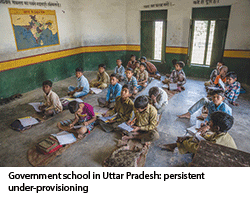 Although ab initio since EducationWorld was launched on the eve of the new millennium, your editors have been steadfast on the issue of raising the national (Centre plus states) outlay on public education to 6 percent of GDP as recommended by the high-powered Kothari Commission way back in 1966, and reiterated by the T.S.R. Subramanian Committee which produced a massive 217-page National Education Policy 2016 draft (which has for mysterious reasons been ignored by the BJP-led government at the Centre), the country’s supine academics and self-serving intelligentsia have never whole-heartedly supported these calls for greater spending on public education. Detailed tabulations published in EducationWorld demonstrating that it’s possible to raise a massive sum of Rs.4.98 lakh crore (see EW March 2017) for investment in public education and primary health — and sent to the country’s top economists for critiquing — have been greeted with resounding silence.
Although ab initio since EducationWorld was launched on the eve of the new millennium, your editors have been steadfast on the issue of raising the national (Centre plus states) outlay on public education to 6 percent of GDP as recommended by the high-powered Kothari Commission way back in 1966, and reiterated by the T.S.R. Subramanian Committee which produced a massive 217-page National Education Policy 2016 draft (which has for mysterious reasons been ignored by the BJP-led government at the Centre), the country’s supine academics and self-serving intelligentsia have never whole-heartedly supported these calls for greater spending on public education. Detailed tabulations published in EducationWorld demonstrating that it’s possible to raise a massive sum of Rs.4.98 lakh crore (see EW March 2017) for investment in public education and primary health — and sent to the country’s top economists for critiquing — have been greeted with resounding silence.
Inevitably, the EW schema to reinvigorate Indian education with a massive investment injection didn’t merit discussion at a national consultation meet organised on July 22 by the RTE Forum — a collective of education advocacy groups and networks across India — and CRY (Child Rights & You) together with the well-known think tank Centre for Budget and Governance Accountability (CBGA). However, a clear unambiguous consensus emerged at the meet that persistent under-provisioning of public education is the prime factor behind the poor quality of public i.e, government provided, K-12 education. Moreover, there was a broad consensus that financing of public education has dropped out of the public discourse.
“We are struggling to convince the Union government that the Centre and the states are under-spending on education. Whenever we raise this issue with the finance ministry in pre-budget and other consultations, we are provided evidence of under-utilisation of outlays and arguments for the need to improve the quality of education delivery. Now we have evidence to prove that inadequacy of expenditure is the root cause of the poor quality of government school education,” says Komal Ganotra, director (policy, advocacy and research) at CRY India.
According to a detailed paper presented by CBGA, the whole narrative of education is focused on improving the quality of education delivery in government schools on the assumption that improvement is possible without greater investment in infrastructure (libraries, laboratories, lavatories), continuous teacher recruitment and training. The CBGA study paper noted that NITI Aayog — the Union government’s think tank which replaced the 50-year Planning Commission in 2015 — has drawn up a three-year action agenda for public K-12 education focused on “improvement of learning outcomes”. But the NITI Aayog agenda is silent on provision of enabling infrastructure, teacher training and contemporary ICT-enabled classrooms, which are preconditions of student retention and improved learning outcomes.
Curiously, despite the Kothari and TSR Subramanian commissions among others, having consistently recommended the allocation of 6 percent of GDP for public education, there’s no shortage of public intellectuals — including popular pundit Swaminathan Aiyar — who argue that the problem isn’t adequacy, but efficiency of expenditure. Although there’s mountainous evidence that the great majority of government — especially state government — primary-secondaries are defined by crumbling buildings, ill-equipped classrooms, multigrade teaching and conspicuous lack of libraries, laboratories and useable lavatories, public intellectuals and policy makers believe that efficiency of expenditure can set right the deep-rooted infirmities of Indian public education.
“It’s amazing that top-rated intellectuals who’ve no doubt been to very well-equipped schools themselves, can’t see that public schools have to be attractive and inviting institutions with libraries, laboratories, toilets and ICT-enabled classrooms to attract and retain students. It’s shameful that they make excuses for scheming politicians who prefer the masses to be steeped in poverty and ignorance to ensure their own re-election. With red herring arguments such as efficiency of expenditure, they fudge the issue of consistent under-funding of public education which is in pathetic condition,” said a despairing delegate at the RTE Forum who preferred to remain anonymous.
Autar Nehru (Delhi)